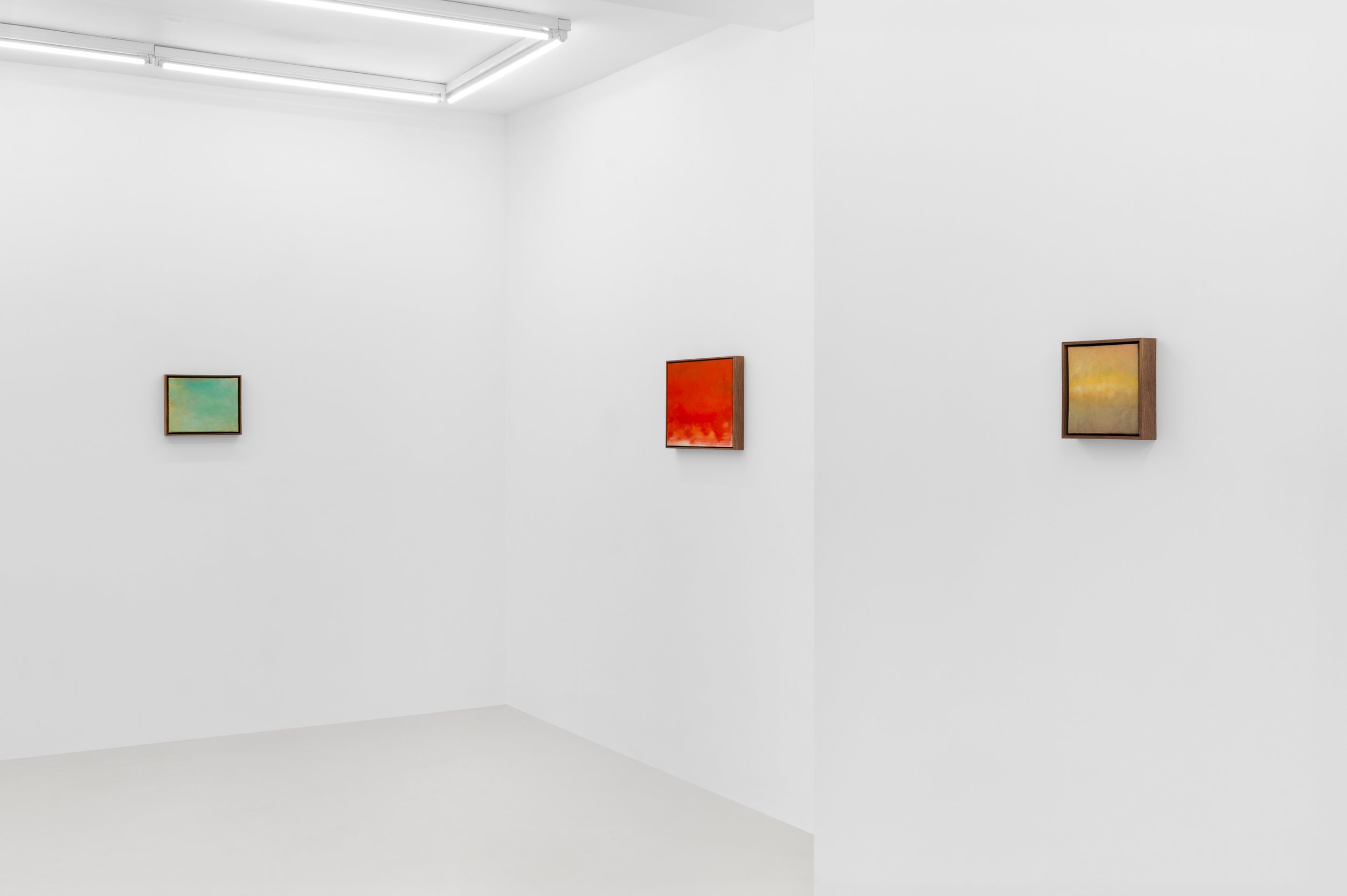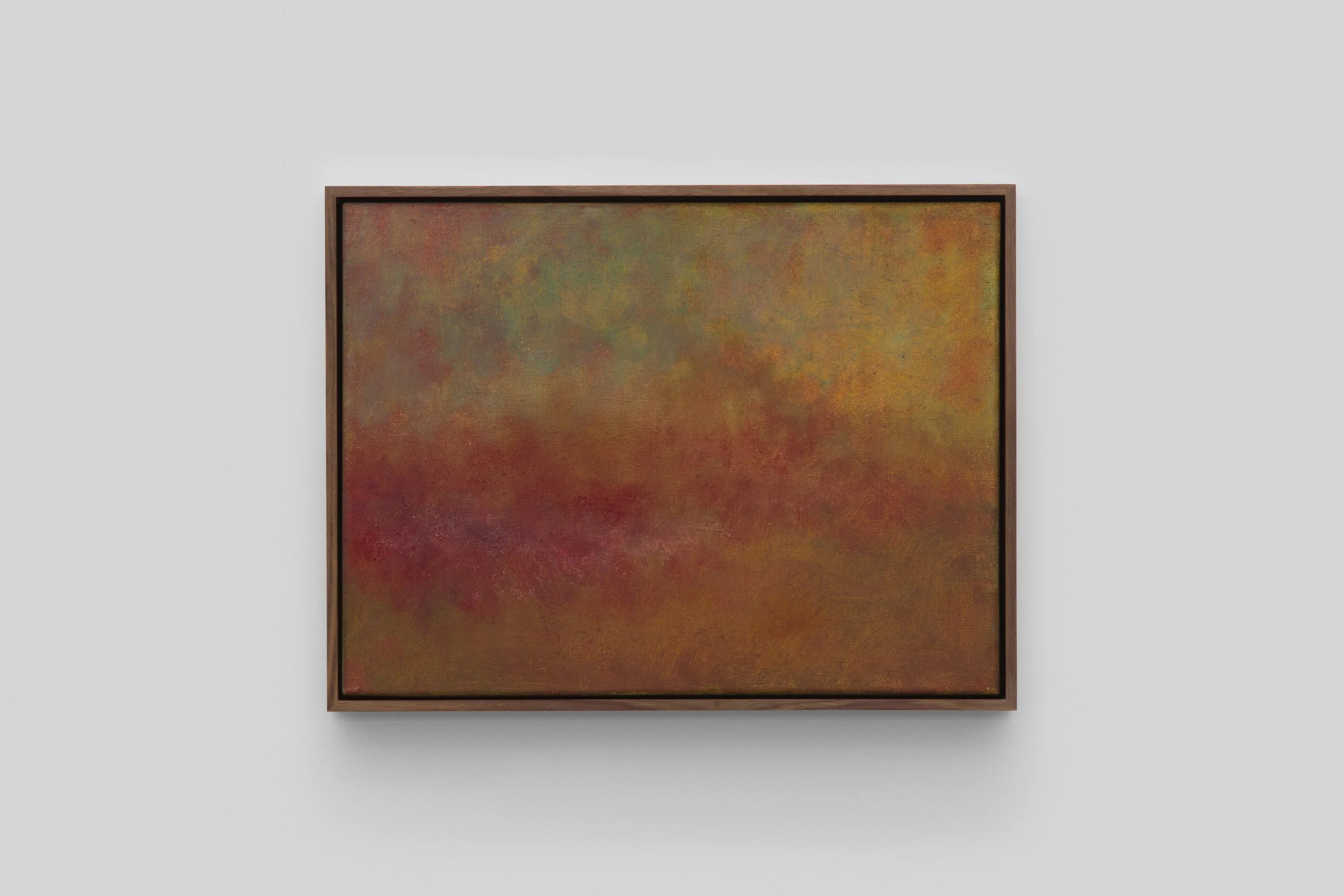
Lewis Brander
Recent Paintings
24 January – 2 March 2024
Vardaxoglou, London
Vardaxoglou Gallery is pleased to present a solo exhibition of new paintings by British artist Lewis Brander (b. 1995, London, UK), across both floors of our newly expanded gallery space. This is the artist’s second solo exhibition with Vardaxoglou and for the first time includes a number of large-scale paintings. An extended essay by Sam Lincoln accompanies the exhibition.
An observer of the shifts in natural light in both Northern and Southern Europe, the colour of the sky has become a constant reference in Lewis Brander’s paintings since returning to London from Greece three years ago. Upon moving to Athens in 2018, the artist became exposed to a new landscape and quality of light. Now working from the top-floor of a disused factory in East London, his studio’s views of the sky have allowed him to sustain this study of light over extended periods. This exhibition comprises new works based on locations of personal significance to the artist, in London and Athens, and continue an ongoing series looking at the view from the artist’s studio window and of the nearby Regents Canal. In his painting Brander references sites of historical significance both to industrial London and also to his own familial history; his ancestors were refugees from Eastern Europe and settled near the area where he now works. Brander combines these histories with a unique interpretation of the historical movements of English romanticism, post-war American abstraction and the School of London painters. The works presented are a device for which light and atmosphere are not only observed and recorded, but a place in which the language and history of painting is played out.
For further information please contact info@vardaxoglou.com.
Read Tom Morton’s review of the exhibition in ArtReview’s March issue
*
Text by Sam Lincoln
As a fresco ages, the pigment on the disintegrating plaster begins to mottle, to fade, and eventually to flake away. Given a two-thousand-year head start, a wall that originally bore an elaborate classical scene may deteriorate beyond hope of reconstruction—but not necessarily beyond legibility as a painting. The quality of the fresco as a work of art can become more obvious, not less, as time strips away the distractions of representation and reveals the crumbling components of the buon fresco technique: calcified lime over pigment, pigment over plaster, plaster over stone.
When these media reveal themselves, they invert the process of the scene’s construction. The visual character of the fresco becomes a map of its own decay. Facing such a crumble, the contemporary viewer does not behold the work of an ancient painter so much as the ongoing collaboration between a painter and the entropic forces of time: a ceiling collapse, a corrosive sea breeze, or a haphazard excavation can all have as much of an effect on a fresco as the original strokes of a brush. And whereas these strokes may have introduced figuration and representation into the scene, the passage of time will force it into abstraction.
The imagery of the crumbling fresco springs to mind before Lewis Brander’s paintings in part because the quality and colour of some of his earlier work (The View Towards Piraeus, 2020-2023; Athens, 2019-2023) recall the earthy, Sinopian palette of Ancient Greek wall-painting. Brander is no stranger to such fragments of antiquity—he lived in Athens from 2018 to 2020, at one point renting an apartment across from the National Archaeological Museum. He was a frequent visitor to the legendary “Spring Fresco” in the museum’s collection, the remains of an Aegean landscape that served as a direct inspiration for his Greek pieces. The connection between Brander’s abstract expanses and their archaeological counterparts becomes more apparent, however, when considering the role of time—and memory, as a function of time—in his work, even when he trades a Mediterranean environment for an English one.
Like a ruined fresco, Brander’s paintings are the aftermath of landscapes. Each of the pieces in this show began with an observation of the sky, in Greece or in England. In some cases, the first few marks of paint arrived in situ, in full view of the subject at hand. In others, Brander started in his studio, catching a view out from the window. But the sky only takes a moment to shift itself into a new composition, and most of these paintings have taken years to complete. Brander therefore spends most of his time painting from memory.
Just as the fresco’s aging process is the source of its growing abstraction, thanks to the dissolution of the ancient scene back into its constituent materials, it is the sky’s ‘aging’—its deterioration into a memory—that serves as the source of Brander’s abstraction. As the initial image of the sky grows faint, he abandons its logic and becomes increasingly faithful to the internal logic of painting itself. A piece may originate in a particular sky on a particular day, but its composition grows of its own accord as Brander returns again and again to develop it. The demands of the work are made by its medium.
In this practice, Brander addresses an old Impressionist question about paint’s capacity to uncover the shapelessness of reality. How to reveal that the gaseous masses that give the sky its dimension, which the mind easily understands to be haze, fog, or cloud, are just clever plays of colour? Of course, Brander benefits from an intervening century in which painting has been pushed well past Impressionism, to the medium specificity of abstract expressionism, and back around again. The works here sample from several different points on this trajectory: the sun igniting the sky over Athens gets the colour-field treatment (Korakas Hill, 2022-2023; Saronic Gulf, 2022-2023), while cloud banks pressing against a north-facing window in Haggerston get something more like lyric abstraction (London Sky, 2023; Studio Window, 2021-2023).
The presence of these influences in Brander’s painting points up his self-conscious approach to manipulating the language of paint, and the patience and curiosity with which he finds his way through a painting. The viewer can trace this process themselves to see how the sky has faded into the surface of the paintings—it’s like watching a fresco fall apart.
Installation Views
Selected Works
-

Lewis Brander
The View Towards Piraeus, 2020-2023
Oil on flax
30 x 40 cm
11 3/4 x 15 3/4 ins -

Lewis Brander
Primrose Hill (Early Summer), 2019-2022
Oil on flax mounted on board
18.5 x 19 cm
7 1/4 x 7 1/2 ins -

Lewis Brander
London, 2019–2023
Oil on flax
24 x 30 cm
9 1/2 x 11 3/4 ins -

Lewis Brander
Athens, 2019-2023
Oil on flax
21.5 x 16 cm
8 1/2 x 6 1/4 ins -

Lewis Brander
Saronic Gulf, 2022–2023
Oil on wood
38 x 37 cm
15 x 14 5/8 ins
Artist Page


